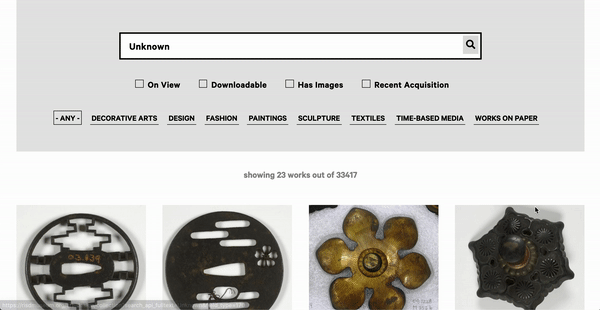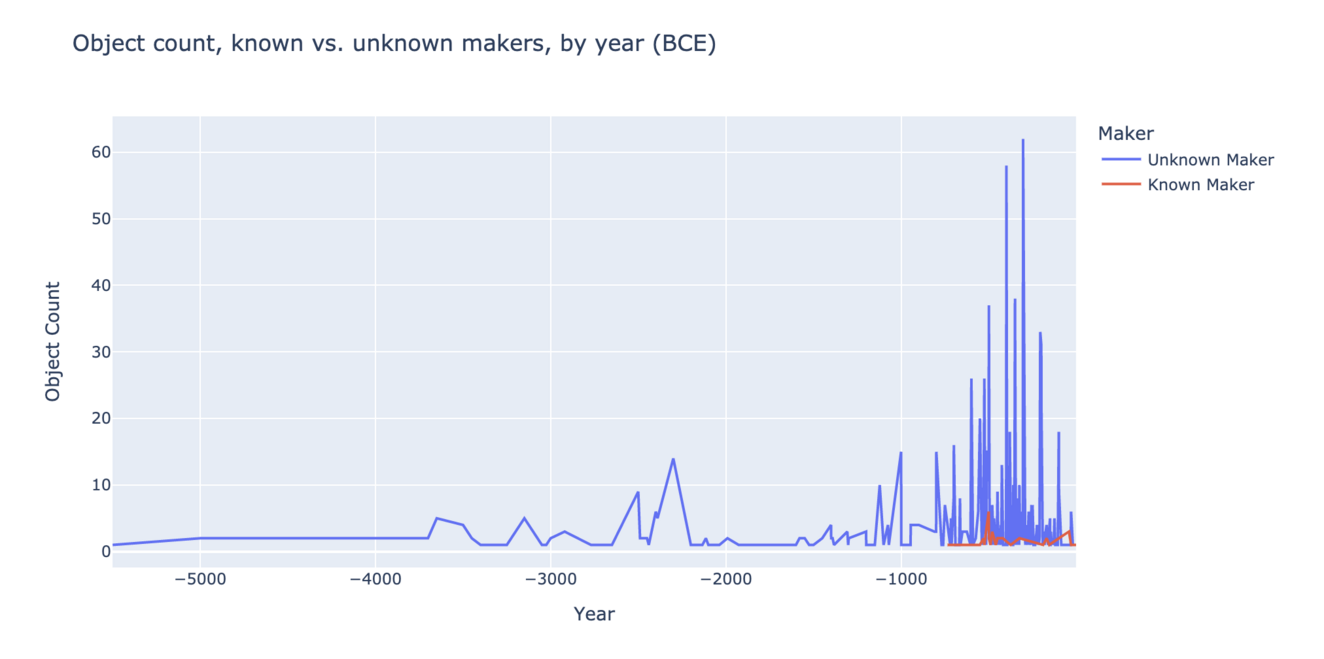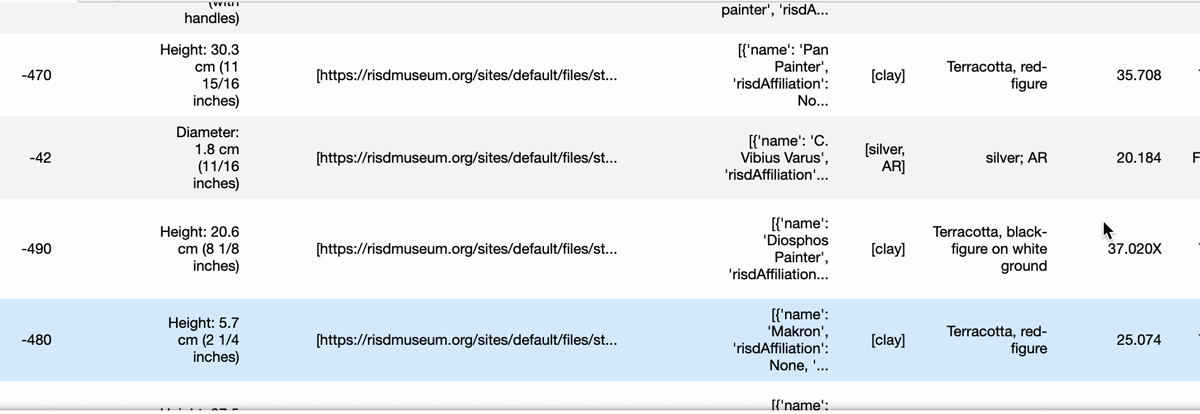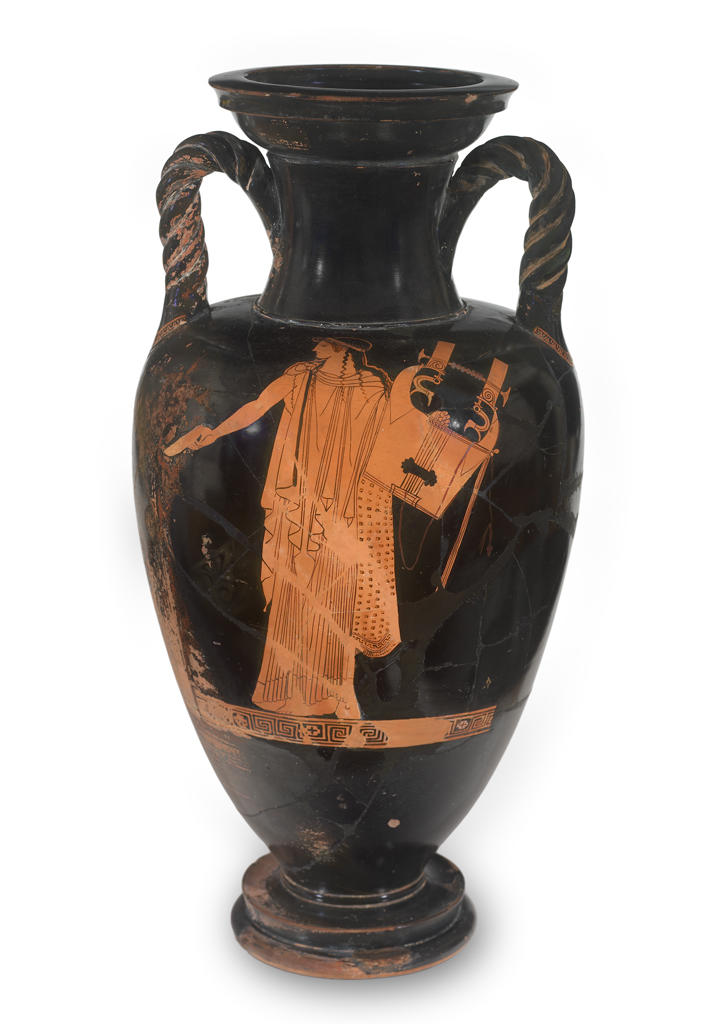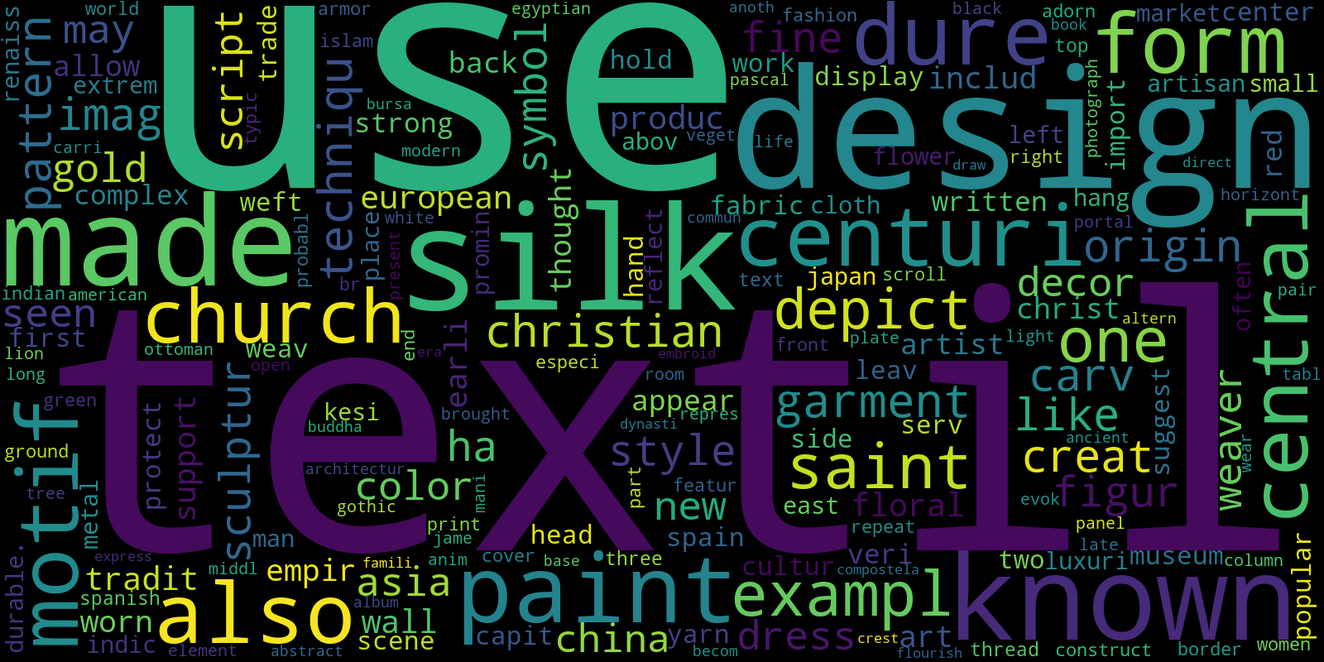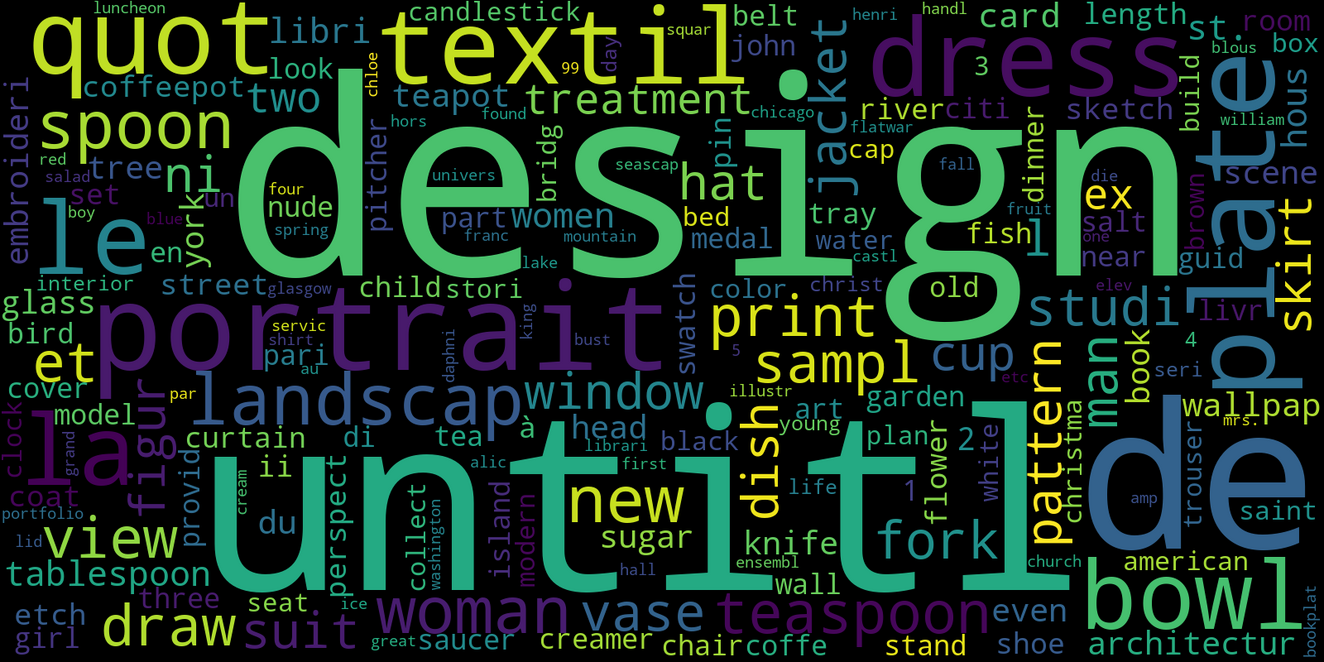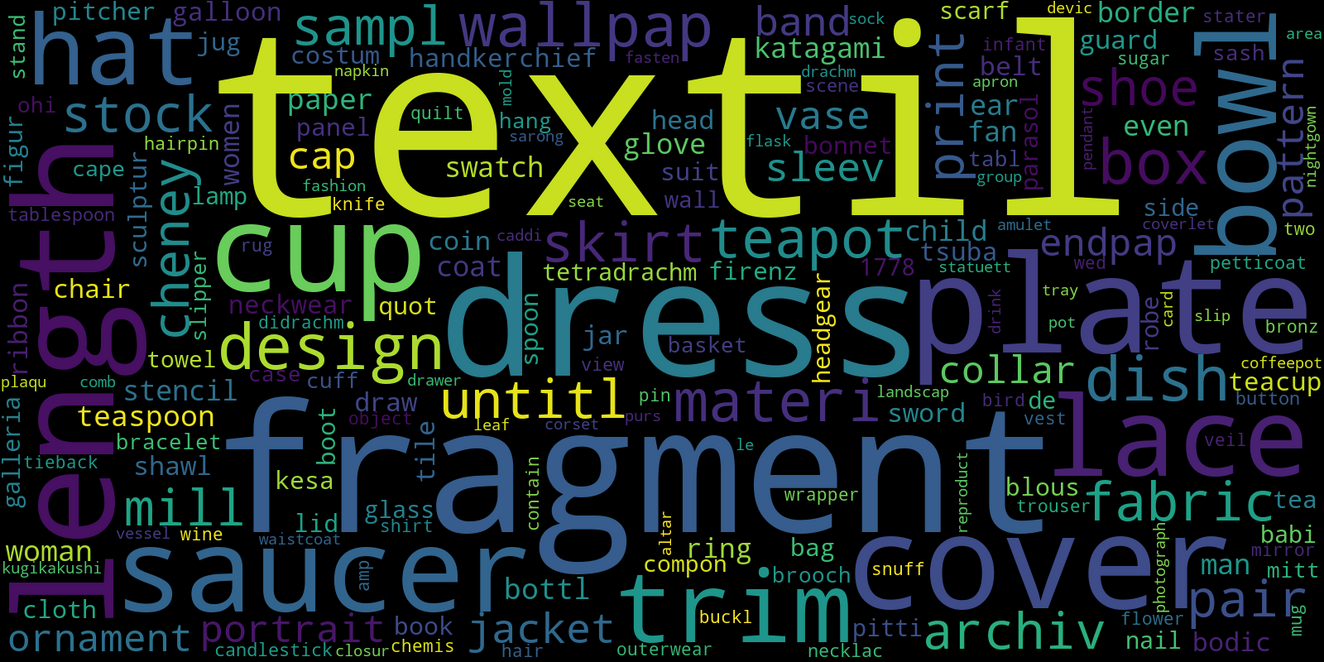During my first week as a summer intern at the RISD Museum, I began researching the deaccessioning process of the Head of an Oba, a commemorative sculpture honoring a former oba, or king, of the Edo people of Benin, West Africa. This bronze head was looted by the British in 1897, and eventually came into the RISD Museum collection. I wanted to know how this work was represented on the museum’s website, and what information was available online about the repatriation process of the head.
When clicking through the object page for Head of an Oba, I scrolled down to the Description section, and found a data field called “Maker,” filled in with “Unknown”. To my surprise, I was able to click on the word “Unknown,” and the museum’s website took me to all the objects with unknown makers or artists available in the online collection. There were thousands of objects. And I had questions.
What types of things were included in this set of objects? What materials or techniques were used in their creation? When were the objects made? What cultures did they originate from? And finally, why are we able to identify artists or makers for some objects, but not others?
As a computer science student, I set out to understand these questions first from a data perspective. My supervisor, Jeremy Radtke, introduced me to the museum’s Collection API, a way to gather data from the museum’s database into a workable format. Once I retrieved the data, I used my knowledge of Python to filter and visualize the data. I used two Python packages designed for this purpose: Pandas for working with the data, and Plotly for visualizing the data.
It’s important to note, however, both the limitations of this data as well as the limitations of the RISD Museum’s collection. First, the museum’s database as displayed online contains over 80,000 objects, but not all of these records are complete or accurate. Many fields in the database are left blank due to unknown information, and completed fields may contain inaccuracies. Additionally, the content of the museum’s collection itself reflects changing priorities from individual curators over time, and it too is limited in scope. It’s important to see these visualizations as explorations of the RISD Museum’s specific database rather than definitive knowledge about the collection or of museums as a whole.
Dates
To begin exploring the data, I wanted to start with dates, because I estimated that nearly all ancient art would be by unknown makers. After gathering the data from the entire collection from the API, I filtered the data by Known Makers and Unknown Makers. Then, I split the data into CE and BCE objects, in order to look at each subset more closely (this was an arbitrary split and I could see how a case could be made for a different split). The collection of objects from before 0 CE was much smaller than the collection of objects from after 0 CE. Next, I plotted the number of objects by year for both known makers and unknown makers.
I was immediately curious about the fact that most of the RISD Museum’s oldest objects have unknown makers. Out of 1236 objects in the collection from prior to 0 CE, only 39 were created by known makers, representing only a few cultures and media.
I asked Ancient Art curator Gina Borromeo about the 39 objects with known makers. Why were only certain ancient objects, particularly from Greek and Roman cultures, able to be identified as having a known maker? Gina identified three reasons for the limited number of known makers.
First, most of the RISD Museum’s ancient collection consists of functional, everyday objects or religious/funerary objects. The original makers of these works might be shocked to find their work classified as art and displayed in a museum. In fact, the Ancient Greeks did not even have a word that perfectly aligns with the present-day English word for art. The closest word that exists is techne, which refers to making or doing.
Second, few maker records from this collection have actually survived. Information about very well-known sculptors, such as the Ancient Greek sculptors Phidias or Polykleitos, have survived. But records from many other makers, especially those of utilitarian objects, did not.
Lastly, the idea of an artist as a singular, unique individual with a distinctive style is both a relatively modern and a Western concept. The Western practice of artist identification started to gain traction around the 12th century. As we approach the present day, the number of known makers increases. Unsurprisingly, there is a distinct increase in known makers in the RISD Museum’s collection from the 1900s to the 2000s.
But who were these 39 known makers from prior to 0 CE? I was surprised to find the name of a familiar Rhode Island city within the data: “Providence Painter”.
Gina informed me that a group of scholars were able to identify an Ancient Greek vase painter by their distinctive style, even though their work was unsigned. The most exemplary form of a certain Athenian vase painter’s work is on a vase that exists in the RISD Museum, so this artist was dubbed the “Providence Painter”. Other artists in this set have names such as the “Painter of Berlin” or “The Concentric Circle Group”. Only a handful of makers have their real names attached to them. Even though artists like the Providence Painter did not sign their works, scholars and connoisseurs applied modern-day conceptions of the artist to identify and categorize ancient makers.
Description and Title Data
After exploring the objects from a time-based perspective, I was curious what words were used to describe and title objects in the RISD Museum, and how those words differed between unknown and known makers. I met with Denise Bastien, the museum’s registrar for documentation and digital resources, to learn about the structure and formatting of the collection data. Denise explained that in order to make the database searchable, there must be consistent standards as to how objects are labeled and identified. The RISD Museum follows the Getty Standards, a set of vocabularies established by the Getty Research Institute. These standards outline best practices for what words to use when describing specific artist techniques, artist names, or cultures. However, the description field, meant to provide a physical or historical description for internal reference, is unstandardized in comparison to other fields in the database. When scrolling through the description field, I noticed that some descriptions were only a sentence, while others were long paragraphs. The title field also was relatively unstandardized. According to the Getty Standards, a title can be given to the piece by the artist, or can be a descriptive name given by a curator or collector. Despite these inconsistencies, the title and description fields hold a significant portion of the descriptive information in the database. I hoped an analysis of these fields would provide me with a clearer picture of the objects in the collection with unknown makers.
To explore these fields in the database, I used a natural-language processing toolkit to collect counts of the most frequently used words in the description fields in the collection, and removed non-descriptive stop-words like “is”, “the”, or “a/an”. From there, I made word clouds of the Title and Description fields.
I spoke to Costume and Textiles curator Laurie Brewer to understand why words relating to textiles appeared so often within the Unknown Maker word clouds. Laurie pointed out that while scholars may be able to hone in on a specific workshop that made a textile, the process of making a textile required many hands that would not be credited individually, particularly in pre-industrial textiles. Asian Art curator Wai Yee Chiong echoed a similar sentiment. For instance, pieces like Chinese bronzes came out of a workshop that might have employed thousands of artisans. For post-industrial textiles, focus would be given to firms, distributors, and manufacturers instead of workers in the textile industry. In contrast to perhaps more contemporary works of art, objects like textiles were not sold with the individual maker(s) in mind. Laurie also emphasized that the RISD Museum has a large textile collection because of its location in New England, a significant hub of textile production. The content of the collection itself, the geographic location of RISD, and the nature of textile-making may all inform the composition of these word cloud visualizations.
Approaching the museum’s database from a data perspective allowed me to understand the strengths and weaknesses of a quantitative approach. First, looking at the data from a high-level perspective allowed me to come up with questions I would not have thought to ask on my own. For instance, who were the 39 makers from before 0 CE, and why do we know those 39? Combining these data-based inquiries with curatorial knowledge allowed me to think about the answers to those questions. However, throughout the process, I became aware of the difficulties of working with and maintaining such a large dataset, despite best attempts to standardize and maintain the database. In addition to inconsistencies that occur within records, there may be inconsistencies between individual record-keepers as to how an object is described. Because the museum’s collection spans such a large time period, there are bound to be mis-labelings and unknowns within the data. I encourage anyone who is interested to use the Museum’s API to ask new questions about the data. My codebase is available here.
Ariel Hirschhorn was the 2021 Andrew W. Mellon Summer Intern in Digital Initiatives and is a senior at the University of Rochester majoring in computer science.

